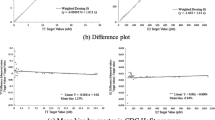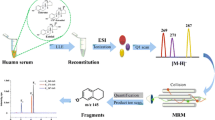Abstract
Purpose
The comparability between serum, plasma, and urinary measurements of estrogen metabolites via liquid chromatography–tandem mass spectrometry (LC–MS/MS) has not been largely explored, and it is unclear if urinary LC–MS/MS measurements are suitable surrogates of circulating levels.
Methods
Serum, plasma (EDTA and heparin), and urinary estrogen/estrogen metabolite levels were measured via LC–MS/MS in paired samples from 64 healthy volunteers (18 men, 20 premenopausal women, 26 postmenopausal women). Geometric means and Spearman correlation coefficients were used to compare individual and combined pathway levels of estrogens/estrogen metabolites across biologic matrices by sex/menopausal status.
Results
Measured concentrations of estrogens/estrogen metabolites across blood matrices were almost identical (percent differences < 4.8%). Parent estrogen concentrations measured in serum and urine were moderately correlated in postmenopausal women (estrone: r = 0.69, estradiol: r = 0.69). Correlations were similar comparing unconjugated serum estradiol to urinary estrone (r = 0.76) and urinary estradiol (r = 0.65) in postmenopausal women but were moderate to low in premenopausal women (r = 0.60, 0.40, respectively)/men (r = 0.33, 0.53, respectively). Comparing metabolite ratios, proportionally higher concentrations of 16-pathway metabolites were measured in urine versus serum across sex/menopausal status groups (e.g., postmenopausal women: 50.3% 16-pathway metabolites/total in urine versus 35.3% in serum).
Conclusions
There is strong agreement between estrogen/estrogen metabolites measurements in serum, heparin plasma, and EDTA plasma. Individual estrogen metabolite concentrations were moderately correlated between urine and serum, but were not well correlated when evaluating pathway- or relative estrogen concentrations. Differences between serum and urine are likely explained by differences in metabolism and/or excretion.

Similar content being viewed by others
References
Key T, Appleby P, Barnes I, Reeves G, Endogenous Hormones and Breast Cancer Collaborative G (2002) Endogenous sex hormones and breast cancer in postmenopausal women: reanalysis of nine prospective studies. J Natl Cancer Inst 94:606–616
Eliassen AH, Missmer SA, Tworoger SS et al (2006) Endogenous steroid hormone concentrations and risk of breast cancer among premenopausal women. J Natl Cancer Inst 98:1406–1415
Fortner RT, Eliassen AH, Spiegelman D, Willett WC, Barbieri RL, Hankinson SE (2013) Premenopausal endogenous steroid hormones and breast cancer risk: results from the Nurses’ Health Study II. Breast Cancer Res: BCR 15:R19
Brown SB, Hankinson SE (2015) Endogenous estrogens and the risk of breast, endometrial, and ovarian cancers. Steroids 99:8–10
Allen NE, Key TJ, Dossus L et al (2008) Endogenous sex hormones and endometrial cancer risk in women in the European Prospective Investigation into Cancer and Nutrition (EPIC). Endocr Relat Cancer 15:485–497
Collaborative Group On Epidemiological Studies of Ovarian Cancer, Beral V, Gaitskell K et al (2015) Menopausal hormone use and ovarian cancer risk: individual participant meta-analysis of 52 epidemiological studies. Lancet 385:1835–1842
Giannandrea F, Paoli D, Figa-Talamanca I, Lombardo F, Lenzi A, Gandini L (2013) Effect of endogenous and exogenous hormones on testicular cancer: the epidemiological evidence. Int J Dev Biol 57:255–263
Ho SM, Lee MT, Lam HM, Leung YK (2011) Estrogens and prostate cancer: etiology, mediators, prevention, and management. Endocrinol Metab Clin N Am 40:591–614, ix
Lasley BL, Mobed K, Gold EB (1994) The use of urinary hormonal assessments in human studies. Ann N Y Acad Sci 709:299–311
Munro CJ, Stabenfeldt GH, Cragun JR, Addiego LA, Overstreet JW, Lasley BL (1991) Relationship of serum estradiol and progesterone concentrations to the excretion profiles of their major urinary metabolites as measured by enzyme immunoassay and radioimmunoassay. Clin Chem 37:838–844
Alper MM, Halvorson L, Lasley B, Mortola J (1994) Relationship between urinary estrone conjugates as measured by enzyme immunoassay and serum estradiol in women receiving gonadotropins for in vitro fertilization. J Assist Reprod Genet 11:405–408
O’Connor KA, Brindle E, Holman DJ et al (2003) Urinary estrone conjugate and pregnanediol 3-glucuronide enzyme immunoassays for population research. Clin Chem 49:1139–1148
Stanczyk FZ, Miyakawa I, Goebelsmann U (1980) Direct radioimmunoassay of urinary estrogen and pregnanediol glucuronides during the menstrual cycle. Am J Obstet Gynecol 137:443–450
Denari JH, Farinati Z, Casas PR, Oliva A (1981) Determination of ovarian function using first morning urine steroid assays. Obstet Gynecol 58:5–9
Kesner JS, Knecht EA, Krieg EF Jr et al (1994) Validations of time-resolved fluoroimmunoassays for urinary estrone 3-glucuronide and pregnanediol 3-glucuronide. Steroids 59:205–211
Kesner JS, Wright DM, Schrader SM, Chin NW, Krieg EF Jr (1992) Methods of monitoring menstrual function in field studies: efficacy of methods. Reprod Toxicol 6:385–400
Brown JB, Blackwell LF, Cox RI, Holmes JM, Smith MA (1988) Chemical and homogeneous enzyme immunoassay methods for the measurement of estrogens and pregnanediol and their glucuronides in urine. Prog Clin Biol Res 285:119–138
Miyakawa I, Stanczyk FZ, March CM, March AD, Goebelsmann U (1981) Urinary estradiol-17-beta-glucuronide assay for gonadotropin therapy. Obstet Gynecol 58:142–147
Bradlow HL, Sepkovic DW, Klug T, Osborne MP (1998) Application of an improved ELISA assay to the analysis of urinary estrogen metabolites. Steroids 63:406–413
Ball P, Reu G, Schwab J, Knuppen R (1979) Radioimmunoassay of 2-hydroxyesterone and 2-methoxyestrone in human urine. Steroids 33:563–576
Emons G, Mente C, Knuppen R, Ball P (1981) Radioimmunoassay for 4-hydroxyoestrone in human urine. Acta Endocrinol 97:251–257
McGuinness BJ, Power MJ, Fottrell PF (1994) Radioimmunoassay of 2-hydroxyestrone in urine. Clin Chem 40:80–85
Xu X, Veenstra TD, Fox SD et al (2005) Measuring fifteen endogenous estrogens simultaneously in human urine by high-performance liquid chromatography-mass spectrometry. Anal Chem 77:6646–6654
Santen RJ, Demers L, Ohorodnik S et al (2007) Superiority of gas chromatography/tandem mass spectrometry assay (GC/MS/MS) for estradiol for monitoring of aromatase inhibitor therapy. Steroids 72:666–671
Xu X, Roman JM, Issaq HJ, Keefer LK, Veenstra TD, Ziegler RG (2007) Quantitative measurement of endogenous estrogens and estrogen metabolites in human serum by liquid chromatography-tandem mass spectrometry. Anal Chem 79:7813–7821
Maskarinec G, Beckford F, Morimoto Y, Franke AA, Stanczyk FZ (2015) Association of estrogen measurements in serum and urine of premenopausal women. Biomark Med 9:417–424
Sampson JN, Falk RT, Schairer C et al (2017) Association of estrogen metabolism with breast cancer risk in different cohorts of postmenopausal Women. Cancer Res 77:918–925
Södergård R, Backstrom T, Shanbhag V, Carstensen H (1982) Calculation of free and bound fractions of testosterone and estradiol-17 beta to human plasma proteins at body temperature. J Steroid Biochem 16:801–810
Falk RT, Xu X, Keefer L, Veenstra TD, Ziegler RG (2008) A liquid chromatography-mass spectrometry method for the simultaneous measurement of 15 urinary estrogens and estrogen metabolites: assay reproducibility and interindividual variability. Cancer Epidemiol Biomark Prev 17:3411–3418
Xu X, Keefer LK, Ziegler RG, Veenstra TD (2007) A liquid chromatography-mass spectrometry method for the quantitative analysis of urinary endogenous estrogen metabolites. Nature Protoc 2:1350–1355
Mukaka MM (2012) Statistics corner: a guide to appropriate use of correlation coefficient in medical research. Malawi Med J 24:69–71
Fillmore CM, Fears TR, Hoover RN et al (2000) Methodological note: biomarkers (sex-hormone binding globulin (SHBG), bioavailable oestradiol, and bioavailable testosterone) and processing of blood samples in epidemiological studies. Biomarkers 5:395–398
Bocchinfuso WP, Hammond GL (1994) Steroid-binding and dimerization domains of human sex hormone-binding globulin partially overlap—steroids and Ca2+ stabilize dimer formation. Biochemistry 33:10622–10629
Funding
This work was supported by the Intramural Research Program of the National Cancer Institute.
Author information
Authors and Affiliations
Corresponding author
Ethics declarations
Conflict of interest
All authors declare that they have no conflicts of interest.
Electronic supplementary material
Below is the link to the electronic supplementary material.
Rights and permissions
About this article
Cite this article
Coburn, S.B., Stanczyk, F.Z., Falk, R.T. et al. Comparability of serum, plasma, and urinary estrogen and estrogen metabolite measurements by sex and menopausal status. Cancer Causes Control 30, 75–86 (2019). https://doi.org/10.1007/s10552-018-1105-1
Received:
Accepted:
Published:
Issue Date:
DOI: https://doi.org/10.1007/s10552-018-1105-1




